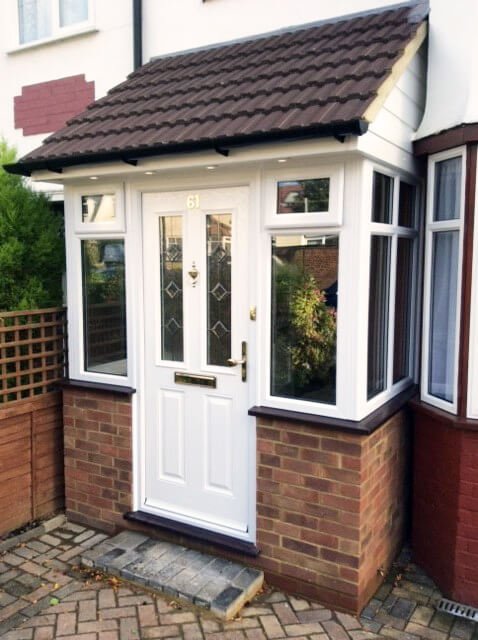Porch
A porch is a covered, single-storey structure that can be enclosed, and projects out from a house or other building. It is a particularly popular option for extending a domestic building, typically at the front entrance, where it can provide additional space, allow the creation of a draft lobby and create an architectural focus. It can also be relatively inexpensive to construct.
A porch can help reduce heat loss from the building, improve energy efficiency and create useful storage space for coats and shoes.
Generally, a porch consists simply of low-level brick dwarf walls, columns, windows and a door. It will require foundations, and the junctions between the walls of the porch and those of the existing building will need to be properly sealed.
Internally, they can be left as open brick or plastered and painted. They will often have a light fitting and an electric socket and a door bell, intruder alarm or other entry system.
Due to their relatively small size, a porch may not require planning permission (although they may in a conservation area or for a listed building, so it is best to check with the local planning authority). Building regulations approval may also be required if the porch is not separated from the house by an internal door and is heated, or if there are structural, accessibility or drainage implications (again, it is best to check with the building control department of the local authority).
There are several different types of porch and it depends to a considerable extent on the existing front entrance as to which is the most suitable. For example, a plain front (as is common with terraced houses) will typically only be suitable for a mounted canopy above the door; a recessed front door (as is common with Victorian and Edwardian houses) will require the recess being blocked in with brickwork and/or glass. Buildings with existing entrance canopies may be capable of being infilled with timber, brick and/or glass, although care should be taken to install a damp-proof course (DPC).
When choosing or designing a porch it is important to make sure that it suits the existing building. Typically this will involve using the same materials, although in some cases, contrast with the existing building can be appropriate. Often, the existing front door can be moved to the exterior face of the porch (if it is suitable), with a new interior door installed between the building and the porch to create a draft lobby.
Porches will often incorporate a large amount of glazing in order to maximise natural light, and so the window design should complement those of the rest of the building or, at least, the frontage.
In terms of budgeting the building of a porch, some of the important factors to consider include:
- Its size.
- The amount of work required to the existing building.
- Whether it will be fully enclosed or not.
- Whether it will be partially or fully glazed on all sides.
- The type of roof – flat or sloping.
- The type of cladding or external brickwork to be used.
NB The Scottish Building Standards, Part I. Technical Handbook – Domestic, Appendix A Defined Terms, suggests that a porch is: ‘…a building attached to and providing a covered entrance to a dwelling.’
[edit] Related articles on Designing Buildings
- Avoiding planning permission pitfalls.
- Basements in buildings.
- Bench.
- Building an extension.
- Conservatory.
- Dwarf wall.
- External doors.
- Hiring an architect as a domestic client.
- How to build a garage.
- How to find a builder.
- Licence for Alterations for Apartment.
- Licence to alter.
- Loft conversion.
- Narthex.
- Planning permission.
- Renovation.
- Widow's walk.
- Wrought iron porch.
Featured articles and news
Government consultations for the summer of 2025
A year of Labour, past and present consultations on the environment, the built environment, training and tax.
CMA competitiveness probe of major housing developers
100 million affordable housing contributions committed with further consultation published.
Homes England supports Greencore Homes
42 new build affordable sustainable homes in Oxfordshire.
Zero carbon social housing: unlocking brownfield potential
Seven ZEDpod strategies for brownfield housing success.
CIOB report; a blueprint for SDGs and the built environment
Pairing the Sustainable Development Goals with projects.
Types, tests, standards and fires relating to external cladding
Brief descriptions with an extensive list of fires for review.
Latest Build UK Building Safety Regime explainer published
Key elements in one short, now updated document.
UKGBC launch the UK Climate Resilience Roadmap
First guidance of its kind on direct climate impacts for the built environment and how it can adapt.
CLC Health, Safety and Wellbeing Strategy 2025
Launched by the Minister for Industry to look at fatalities on site, improving mental health and other issues.
One of the most impressive Victorian architects. Book review.
Common Assessment Standard now with building safety
New CAS update now includes mandatory building safety questions.
RTPI leader to become new CIOB Chief Executive Officer
Dr Victoria Hills MRTPI, FICE to take over after Caroline Gumble’s departure.
Social and affordable housing, a long term plan for delivery
The “Delivering a Decade of Renewal for Social and Affordable Housing” strategy sets out future path.
A change to adoptive architecture
Effects of global weather warming on architectural detailing, material choice and human interaction.
The proposed publicly owned and backed subsidiary of Homes England, to facilitate new homes.
How big is the problem and what can we do to mitigate the effects?
Overheating guidance and tools for building designers
A number of cool guides to help with the heat.
The UK's Modern Industrial Strategy: A 10 year plan
Previous consultation criticism, current key elements and general support with some persisting reservations.
Building Safety Regulator reforms
New roles, new staff and a new fast track service pave the way for a single construction regulator.

























